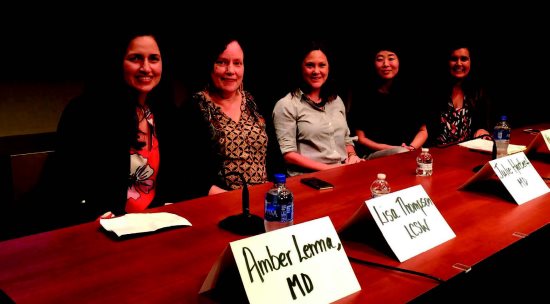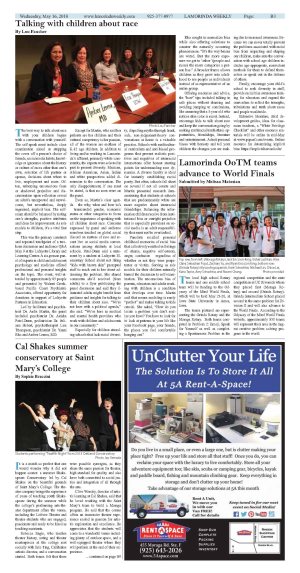| | Published May 16th, 2018
| Talking with children about race
| | | By Lou Fancher |  | | Photo Lou Fancher |
The best way to talk about race with your children begins with a conversation with yourself. The self-speak must include close examination aimed at stripping the cover off a person's choice of friends, social media habits, knowledge or ignorance about the history or culture of races other than one's own, selection of life partner or spouse, decisions about where to live, employment and more. Often, unburying unconscious fears or shadowed prejudice and discrimination upon reflection reveal an adult's unexpected and unwelcome, but nevertheless, deeply ingrained, implicit bias. The self-exam should be balanced by noting one's strengths, positive attributes and ideas for improvement. As role models to children, it's a vital first step.
 This was the primary construct and repeated touchpoint of a two-hour discussion and audience Q&A May 9 at the Lafayette Library and Learning Center. A six-person panel of experts in child and adolescent psychology and medicine offered professional and personal insights on the topic. The event, well-attended by approximately 85 people and presented by Walnut Creek-based Pacific Coast Psychiatric Associates, offered opportunity for donations in support of Lafayette Partners in Education.
This was the primary construct and repeated touchpoint of a two-hour discussion and audience Q&A May 9 at the Lafayette Library and Learning Center. A six-person panel of experts in child and adolescent psychology and medicine offered professional and personal insights on the topic. The event, well-attended by approximately 85 people and presented by Walnut Creek-based Pacific Coast Psychiatric Associates, offered opportunity for donations in support of Lafayette Partners in Education.
 Led by facilitator and psychiatrist Dr. Ardis Martin, the panel included psychiatrist Dr. Anisha Patel-Dunn, pediatrician Dr. Juliana Hebert, psychotherapist Lisa Thompson, psychiatrist Dr. Yanni Rho and Amber Lerma, MD.
Led by facilitator and psychiatrist Dr. Ardis Martin, the panel included psychiatrist Dr. Anisha Patel-Dunn, pediatrician Dr. Juliana Hebert, psychotherapist Lisa Thompson, psychiatrist Dr. Yanni Rho and Amber Lerma, MD.
 Except for Martin, who said her patients are her children and their cultural competency is her passion, all of the women are mothers of K-12 age children. In addition to living and/or working in Lamorinda's affluent, primarily white community, the experts were selected in part to present diversity. Mexican, African American, Asian, Indian and white perspectives added dimension to the conversation. The only disappointment, if one must be stated, is that no men were on the panel.
Except for Martin, who said her patients are her children and their cultural competency is her passion, all of the women are mothers of K-12 age children. In addition to living and/or working in Lamorinda's affluent, primarily white community, the experts were selected in part to present diversity. Mexican, African American, Asian, Indian and white perspectives added dimension to the conversation. The only disappointment, if one must be stated, is that no men were on the panel.
 Even so, Martin's clear agenda - the why, what and how to's - transcended gender, economic status or other categories to focus on the importance of speaking with all children about race. Concerns expressed by panel and audience members touched on global social discord on matters of race and recent live or social media conversations among students at local schools. Patel-Dunn said a statement by a student at Lafayette Elementary School about not liking "kids with brown skin" prompted staff to reach out to her about addressing the problem. She shared comments she'd received (from adults) to a flyer publicizing the panel discussion and said they illustrated adults might benefit from guidance and insights for talking to their children about race. "We're not here with a political agenda," she said. "We're here as medical and mental health providers who work with children and adolescents in our community."
Even so, Martin's clear agenda - the why, what and how to's - transcended gender, economic status or other categories to focus on the importance of speaking with all children about race. Concerns expressed by panel and audience members touched on global social discord on matters of race and recent live or social media conversations among students at local schools. Patel-Dunn said a statement by a student at Lafayette Elementary School about not liking "kids with brown skin" prompted staff to reach out to her about addressing the problem. She shared comments she'd received (from adults) to a flyer publicizing the panel discussion and said they illustrated adults might benefit from guidance and insights for talking to their children about race. "We're not here with a political agenda," she said. "We're here as medical and mental health providers who work with children and adolescents in our community."
 Especially for children attending schools that lack racial diversity, dispelling myths through frank, safe, non-judgement-heavy conversations at home is a valuable practice. Schools with multicultural curriculum and anti-biased programs that present realistic positives and negatives of interracial interactions offer honest starting points for understanding race dynamics. A diverse faculty is ideal for instantly establishing racial parity. But often, schools fall short on several if not all counts and Martin presented research demonstrating that students at schools that are predominantly white are more negative about interracial friendships. Balancing the information children receive from institutional bias or outright prejudice that is especially prevalent on social media is an adult responsibility that must not be overlooked.
Especially for children attending schools that lack racial diversity, dispelling myths through frank, safe, non-judgement-heavy conversations at home is a valuable practice. Schools with multicultural curriculum and anti-biased programs that present realistic positives and negatives of interracial interactions offer honest starting points for understanding race dynamics. A diverse faculty is ideal for instantly establishing racial parity. But often, schools fall short on several if not all counts and Martin presented research demonstrating that students at schools that are predominantly white are more negative about interracial friendships. Balancing the information children receive from institutional bias or outright prejudice that is especially prevalent on social media is an adult responsibility that must not be overlooked.
 Panelists recalled personal childhood memories of racial bias that collectively resulted in feelings of shame, negative self-esteem, anger, confusion - regardless of whether or not they were perpetrator or victim. Serving as role models for their children naturally turned the discussion to self-examination. The unconscious bias of parents, educators and adults working with children is a condition that develops over time. Martin said that means modeling is rarely "perfect" and makes talking to kids crucial. She asked, "How do you locate a problem you don't realize you have? You have to look for it: look at patterns in your life like your Facebook page, your friends, the places you feel comfortable hanging out."
Panelists recalled personal childhood memories of racial bias that collectively resulted in feelings of shame, negative self-esteem, anger, confusion - regardless of whether or not they were perpetrator or victim. Serving as role models for their children naturally turned the discussion to self-examination. The unconscious bias of parents, educators and adults working with children is a condition that develops over time. Martin said that means modeling is rarely "perfect" and makes talking to kids crucial. She asked, "How do you locate a problem you don't realize you have? You have to look for it: look at patterns in your life like your Facebook page, your friends, the places you feel comfortable hanging out."
 Rho sought to normalize bias while also offering solutions to counter the naturally occurring phenomenon. "It's the way brains are wired. But the more exposure we get to 'other' (people and races) the more categories a person has." A broader frame allows children as they grow into adulthood to see people as individuals instead of as representative of an entire group.
Rho sought to normalize bias while also offering solutions to counter the naturally occurring phenomenon. "It's the way brains are wired. But the more exposure we get to 'other' (people and races) the more categories a person has." A broader frame allows children as they grow into adulthood to see people as individuals instead of as representative of an entire group.
 Offering resources and advice, the "how" tips included talking in safe places without shaming and avoiding jumping to conclusions, like assuming that a 3-year-old who notices skin color is racist. Instead, encourage kids to talk about race and keep the conversation going by seeking multiracial/multiethnic opportunities, friendships, literature and entertainment. Admit personal biases with honesty and tell your children the changes you are making due to increased awareness. Because we can never totally prevent the problems associated with racial bias from impacting and shaping our children, make sure the conversation with school-age children includes age-appropriate, nonviolent methods for them to defend themselves or speak out in the defense of others.
Offering resources and advice, the "how" tips included talking in safe places without shaming and avoiding jumping to conclusions, like assuming that a 3-year-old who notices skin color is racist. Instead, encourage kids to talk about race and keep the conversation going by seeking multiracial/multiethnic opportunities, friendships, literature and entertainment. Admit personal biases with honesty and tell your children the changes you are making due to increased awareness. Because we can never totally prevent the problems associated with racial bias from impacting and shaping our children, make sure the conversation with school-age children includes age-appropriate, nonviolent methods for them to defend themselves or speak out in the defense of others.
 Finally, encourage your child's school to seek diversity in staff, provide racial bias awareness training for educators and expand the curriculum to reflect the triumphs, tribulations and truth about races and people worldwide.
Finally, encourage your child's school to seek diversity in staff, provide racial bias awareness training for educators and expand the curriculum to reflect the triumphs, tribulations and truth about races and people worldwide.
 Extensive literature, child development guides, ideas for classroom teachers, a "White Privilege Checklist" and other resource materials will be online in mid-May at www.pcpasf.com/events. Online resource for determining implicit bias: https://implicit.harvard.edu/
Extensive literature, child development guides, ideas for classroom teachers, a "White Privilege Checklist" and other resource materials will be online in mid-May at www.pcpasf.com/events. Online resource for determining implicit bias: https://implicit.harvard.edu/


|
| | | | | | | | | | | | |



